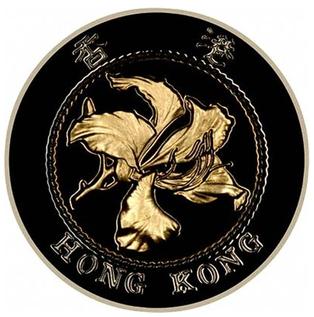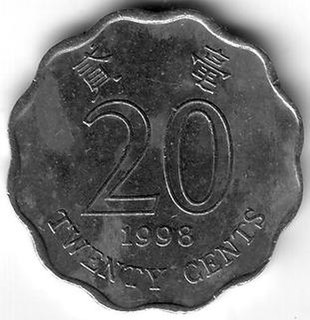Related Research Articles
The Hong Kong coinage, including 10¢, 20¢, 50¢, $1, $2, $5 & $10, is issued by Hong Kong Monetary Authority on behalf of the Government of Hong Kong. From 1863 until 1992 these coins were embossed with the reigning British monarch's effigy. Since 1 January 1993, a new series depicting the bauhinia flower was gradually issued, including a new denomination of $10. Since the beginning of the coin replacement programme on 1 January 1993, over 585 million coins featuring Queen Elizabeth II have been withdrawn from circulation. However, these coins remain legal tender. The total value of coins in circulation in Hong Kong can be found in Monthly Statistical Bulletin and the Annual Report
The one-dollar coin is the fourth-highest and fourth-lowest denomination coin of the Hong Kong dollar.
The coins of the New Zealand dollar are used for the smallest physical currency available in New Zealand. The current denominations are ten cents, twenty cents, fifty cents, one dollar and two dollars. The $1 and $2 coins are minted in a gold colour, the 20c and 50c coins are silver colour and the 10c coin is plated in copper.

The twenty-five øre coin was a coin of the Danish krone. It was the lowest-denomination coin in the country when it was demonetised on 1 October 2008.

The one-cent banknote was the smallest denominated banknote issued in Hong Kong. They were issued by the government and were initially released on 30 May 1941 and printed by Noronha and Company Limited to provide small change because of a lack of coinage brought on by the second world war. The first issue was 42 by 75 mm, the obverse was brown with a serial number of seven numbers with either no prefix or an A or B prefix. This side was mostly in English, except for "Government of Hong Kong" which was also in Chinese. The reverse was red and the denomination in English and Chinese. After the Japanese take over of Hong Kong the issue was replaced by the Japanese Military Yen.
The ten-cent coin is the lowest-denomination circulating coin of the Hong Kong dollar. With a diameter of 17.5 mm and a mass of 1.85 g it is also the smallest in size and weight. It is the oldest coin denomination to still be in circulation in Hong Kong. Since its first issue in 1863, there has only been one period (1942–1947) where the coin was not in use.

The ten-dollar coin is the highest-valued circulating coin issued in Hong Kong.

The two dollar coin is the third-highest denomination coin of the Hong Kong dollar. Since its introduction in 1976, it is one of two circulating coins to not be round. The two dollar coin is a dodecagonal scallop in shape, and made of cupro-nickel.

The twenty-cent coin is a coin of the Hong Kong dollar. It is the second-smallest denomination coin in Hong Kong. There have been two different periods of usage for a twenty-cent coin: the first, round twenty-cent was issued from 1866 to 1905, and the current scallop-shaped coin was introduced in 1975.
The fifty-cent coin was first introduced as a .900 purity silver half dollar in 1866. These coins were 13.41 grams, with a diameter of 32 mm, thickness of 2 mm, and a reeded edge. The design was similar to the British trade dollar, except the image of Britannia was replaced by Queen Victoria. The dates of issue were 1866-67 with only 59,000 issued for both dates combined.

The one mil coin was the smallest denomination of the Hong Kong dollar from 1863 to 1866, after this date it was no longer issued but may have circulated much longer. Its value was one tenth of a cent, or a thousandth of a dollar. It was minted by the Royal Mint, it features the Royal cypher of "VR", of the reigning monarch Queen Victoria at the time, but didn't feature a profile of the face of the monarch as all other coins did, due to the hole in the middle.

The one-cent coin was the smallest-denomination coin of the Hong Kong dollar since 1866 until its replacement in 1941 by the one-cent note. During World War II the loss of coins dated 1941 along with their subsequent melting during the Japanese occupation of Hong Kong has resulted in the survival of no more than 100 coins.
The Hong Kong five-cent note was issued by the government, initially released on 16 October 1941 and printed by Noronha and Company Limited to provide small change because of a lack of coinage brought on by the Second World War. The first issue was 48 by 85 mm; the obverse was green with serial numbers of seven numbers with no prefix. This side was mostly in English, except for "Government of Hong Kong" which was also in Chinese. The reverse was blue and the denomination in English and Chinese. After the Japanese take-over of Hong Kong, the issue was replaced by the Japanese military yen.
The ten cent banknote was a banknote issued in Hong Kong. They were issued by the government, and were initially released on 16 October 1941 and printed by Noronha and Company Limited, to provide small change because of a lack of coinage brought on by the Second World War, and an influx of people because of the Second Sino-Japanese War. The first issue was 55 by 95 mm, and the obverse was red with a serial number of seven numbers, with no prefix. This side was mostly in English, except for "Government of Hong Kong" which was also in Chinese. The reverse was blue and had the denomination in English and Chinese. After the Japanese take over of Hong Kong, the issue was replaced by the Japanese Military Yen.

The one dollar note was first issued by The Hongkong and Shanghai Banking Corporation from 1872 to 1935. No other bank issued this denomination. In 1935 the Government of Hong Kong took over the issuing and became the sole issuer for this denomination. There was a continuous issue till the Second World War when it was replaced by the Japanese Military Yen, and this issue was resumed after the war in 1946, until 1960, when it was replaced with a coin. The initial issue by the HSBC was brown on the obverse and red on the reverse. The note was stylised and was 189 by 123 mm. This was changed in 1889 to a new design and size, now it was 129 by 86 and the colours were blue on the obverse and red on the reverse. This lasted till 1904 when a new issue was released, being 132 by 90 mm and green on the obverse and orange the reverse. The colour and size of this issue was changed in 1923 to 131 by 93 mm and was green on both sides. The last issue by the HSBC was in 1926 when a new design 131 by 95 was issued in blue obverse and purple reverse, both sides with a yellow background.
The five-dollar note was first issued in 1858 by the Mercantile Bank, 1865 by the Standard Chartered Bank, 1866 by the Oriental Bank Corporation, 1897 by The Hongkong and Shanghai Banking Corporation, and 1894 by the National Bank of China. There was a continuous issue till the Second World War in different colours and dimensions, and this issue was resumed after the war in 1946, by the HSBC and Standard Chartered banks. The various banks' designs were somewhat standardised in 1970 when the Chartered Bank changed the issue from green to brown, as this was the colour of the HSBC issue. The Standard Charted Bank issued two colours from 1967-70, a yellow and green note. These are described as being a yellow and green key in reference to the image of two keys on either side of the banknote. This denomination was replaced by a coin in 1976.
The Romanian one-ban coin is a unit of currency equalling one one-hundredth of a Romanian leu. It is the lowest-denomination coin of the present currency and has been minted every year since the leu was redenominated in 2005. As well as Romania, the coin has been minted in the United Kingdom (1867), Germany (1900) and Russia (1952).
The New Zealand two-dollar coin is the largest-denomination coin of the New Zealand dollar. It was introduced along with the one-dollar coin in 1990. Both are made from an alloy of aluminium and brass. It is the largest and heaviest coin in circulation, weighing ten grams and measuring 26.5 millimetres in diameter. Its thickness is 2.7 mm, only 0.4 mm thinner than the one-dollar coin, thus it is the second-thickest coin in the country's circulation.
The New Zealand one-cent coin was the smallest denomination coin of the New Zealand dollar from the currency's introduction in 1967 to its demonetisation, along with the two-cent coin, on 30 April 1990. With a diameter of 17.53 millimetres, it is the smallest coin ever issued of the dollar, and at 2.07 grams in mass the lightest as well. Its reverse featured a fern leaf, a sign of New Zealand, associated also with its national rugby union team. The image was designed by Reginald George James Berry, who designed the reverses for all coins introduced that year.
The New Zealand fifty-cent coin is a coin of the New Zealand dollar. It was the largest by denomination, diameter and mass to have been introduced on the decimalisation of the currency on 10 July 1967, replacing the pre-decimal crown coin. A total of 81,585,200 pre-2006 50 cent coins were issued, with a total value of $40,792,600.00
References
- Sources
- Ma Tak Wo 2004, Illustrated Catalogue of Hong Kong Currency, Ma Tak Wo Numismatic Co., LTD Kowloon Hong Kong. ISBN 962-85939-3-5
- Notes
- ↑ http://worldcoingallery.com/countries/display.php?image=img2/84-39&desc=Hong Kong km39 5 Dollars (1976-1979)&query=Hong Kong
- ↑ http://worldcoingallery.com/countries/display.php?image=img11/84-56&desc=Hong Kong km56 5 Dollars (1985-1991)&query=Hong Kong
- ↑ http://worldcoingallery.com/countries/display.php?image=img2/84-65&desc=Hong Kong km65 5 Dollars (1993--)&query=Hong Kong
- ↑ http://worldcoingallery.com/countries/display.php?image=img14/84-77&desc=Hong Kong km77 5 Dollars (1997) Shou character&query=Hong Kong
- ↑ Ma Tak Wo (2004). Illustrated Catalogue of Hong Kong Currency (6 ed.). Ma Tak Wo Numismatic Co., LTD Kowloon Hong Kong. ISBN 962-85939-3-5.
- ↑ Krause, Chester L. (2001). Standard Catalog of World Coins . Iola, Wisconsin: Krause Publications. pp. 921. ISBN 9780873418843.